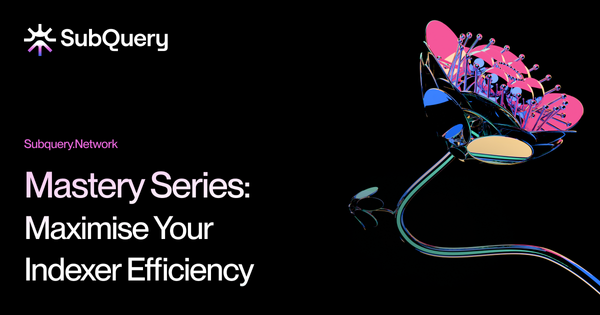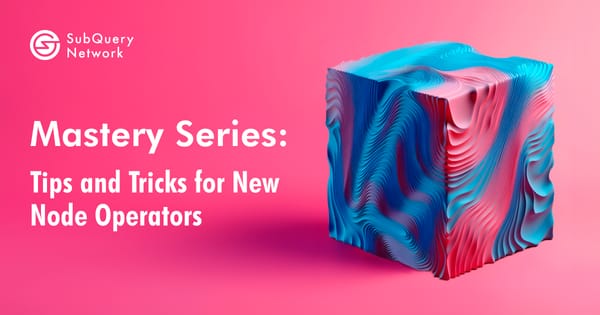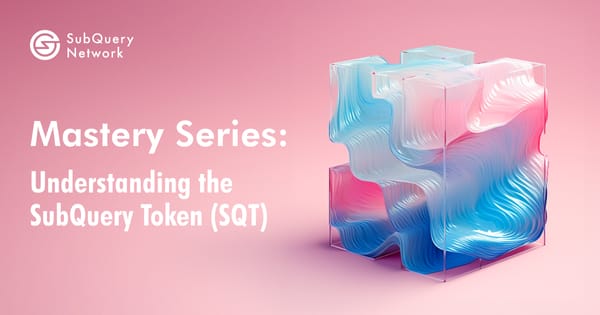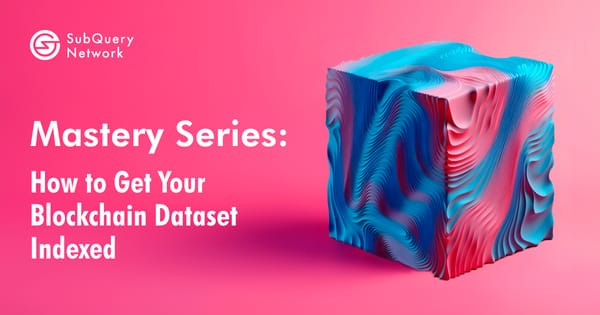Welcome back for another instalment of the SubQuery Mastery Series, where we help you navigate and master the SubQuery Network.
Node runners are the lifeline of the SubQuery Network, without them SubQuery’s mission to Decentralise the Future is virtually impossible. Our node runners (titled ‘Node Operators’) are responsible for serving infrastructure, be it indexed data or RPC (Remote Procedure Call) requests, to accelerate the dApp development experience.
If you’re a keen node runner, or even a novice with solid technical knowledge, then this article will give you everything you need to know to get started!
What is a Node Operator?
A SubQuery Node Operator participates in the SubQuery Network by running and maintaining nodes responsible for either indexing blockchain data or providing RPC endpoint services for the network (or both).
The Node Operators play a crucial role in decentralising the SubQuery Network, contributing to the overall health and efficiency of the network and as a Web3 infrastructure service they simplify the data layer for various applications and use cases. Not to mention, they can also recieve a very attractive APY (currently 38.4%) while they’re at it!
Why Run a Node on the SubQuery Network?
SubQuery offers a robust ecosystem that empowers users to efficiently manage data indexing and RPC services while fostering a competitive and equitable environment within the network. By running a node on the SubQuery Network and serving as a Node Operator, you will be contributing to a leading network on an unstoppable mission to pioneer Web3 infrastructure.
Here are some more reasons why SubQuery Network is a force to be reckoned with:
- Flexibility
SubQuery remains open source, ensuring continual accessibility and adaptability. Users retain the liberty to tailor datasets precisely to their requirements and align them with their Web3 applications. By defining the structure of their API endpoints, users eliminate the need to aggregate queries from multiple API sources. This not only saves time and resources but also elevates the overall user experience.
- Simplicity
Utilising SubQuery does not necessitate expert-level proficiency. With just three essential files (Project Manifest file, GraphQL Schema file, and Mappings file), users can swiftly construct a functional SubQuery project. SubQuery is engineered to be more user-friendly and conducive to development than counterparts. The prosperity of SubQuery hinges on the collaborative success of users shaping its evolution.
- Indexers/Delegator Fairness
SubQuery mitigates the disparities often seen between indexers and delegators prevalent in other blockchain indexing systems. Unlike other blockchain indexer platforms where sudden rate alterations disadvantage delegators, SubQuery mandates indexers to transparently communicate any adjustments to query fees and revenue sharing rates over an entire staking cycle, fostering a fairer ecosystem.
- Market Dynamics
Through an innovative marketplace, SubQuery facilitates the interaction between data buyers and sellers, addressing the challenge of predicting future data demand. Within SubQuery, data consumers can initiate Purchase Orders via on-chain smart contracts, eliminating the need for curators. In contrast, conventional blockchain indexers rely on curators to anticipate demand, rewarding them upon its realisation. Purchase orders, as on-chain contracts, empower consumers to procure data at specified rates and volumes, stimulating competition among indexers and leading to price reductions within SubQuery projects.
- Performance Incentives
SubQuery reinforces performance standards by prompting consumers to report on speed metrics while unlocking micropayment indexes. This incentivizes SubQuery network indexers to maintain high uptime and low latency infrastructure, optimising performance and reliability.
How do Node Operators Receive Rewards?
As we mentioned earlier, you can receive a very attractive APY as a Node Operator (currently sitting at 38.4%). SubQuery Node Operators are rewarded with SQT tokens in two ways:
- Network Inflation Rewards
SubQuery Node Operators can run SubQuery projects and receive network inflation rewards. Inflation rewards are affected by the popularity and the support from the Consumers based on the amount of “boost” from SQT token holders. The Network Inflation Rewards will only be distributed to Node Operators if they are running the data indexer/RPC projects with “boost”, and the Network Inflation Rewards will be distributed to Node Operators running that project (we will talk about how to boost a project and what boost rewards are in a later article)A common example is where a Web3 company publishes its own Project to the SubQuery Network which includes all their smart contracts (smart contract addresses, input parameters, outputs, etc) and specific on-chain data extracting requirements. However, it does not want to run by itself without a Node Operator. This Web3 company, as a consumer of the data, may “boost” the project with SQT tokens to ensure it is attractive to Node Operators.
Node Operators will select and run this indexer project because they can receive higher network inflation rewards due to the high “boosting”. The Node Operators will receive “Boost Allocation Rewards” (of which the actual amount is affected by the amount of SQT allocated to the project) from the Network Inflation Rewards as mentioned above.
- Demand Driven Query Rewards
SubQuery Network Consumers can purchase services from Node Operators in the form of RPC queries from RPC Providers or indexed data from Data Indexers. The Node Operators can receive SQT tokens by serving requests for a Project, this is done via arrangement with the Consumer as either a Closed Agreement or Flex Plans (PAYG).
How to Get started
Hardware
Node software is tested on x86-64/AMD64 and ARM architectures.
Prerequisites
- Linux environment (Ubuntu / Cent OS / Debian)
- Docker
- PostgreSQL database
- A minimum amount of SQT (currently 200,000 SQT) is required to stake in the staking contract to become a SubQuery Node Operator
There are 2 ways to set up and run a Node Operator Service in Docker
Once you have set up a Docker, you can follow this guide “How to Become a Node Operator” to register yourself as a Node Operator, and index a project or sync an RPC endpoint step-by-step.
Conclusion
If you are thinking about becoming a Node Operator on the SubQuery Network then we highly recommend joining our Discord and heading to the SubQuery Network section. Here you can ask for help from all our existing Node Operators or one of the team directly.
We’d love to have you onboard!
About SubQuery
SubQuery Network is innovating web3 infrastructure with tools that empower builders to decentralise the future. Our fast, flexible, and open data indexer supercharges dApps on over 200 networks, enabling a user-focused web3 world. Soon, our Data Node will provide breakthroughs in the RPC industry, and deliver decentralisation without compromise. We pioneer the web3 revolution for visionaries and forward-thinkers. We’re not just a company — we’re a movement driving an inclusive and decentralised web3 era. Let’s shape the future of web3, together.
Linktree | Website | Discord | Telegram | Twitter | Blog | Medium | LinkedIn | YouTube







